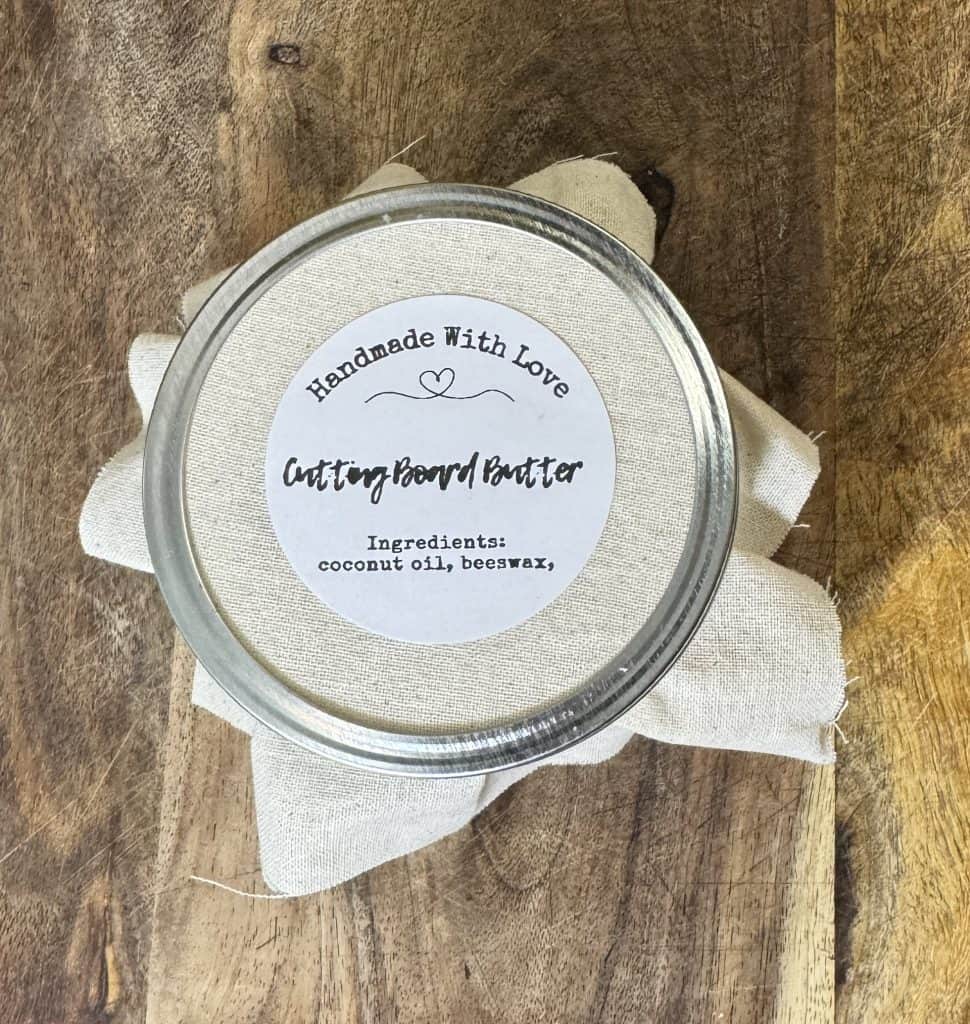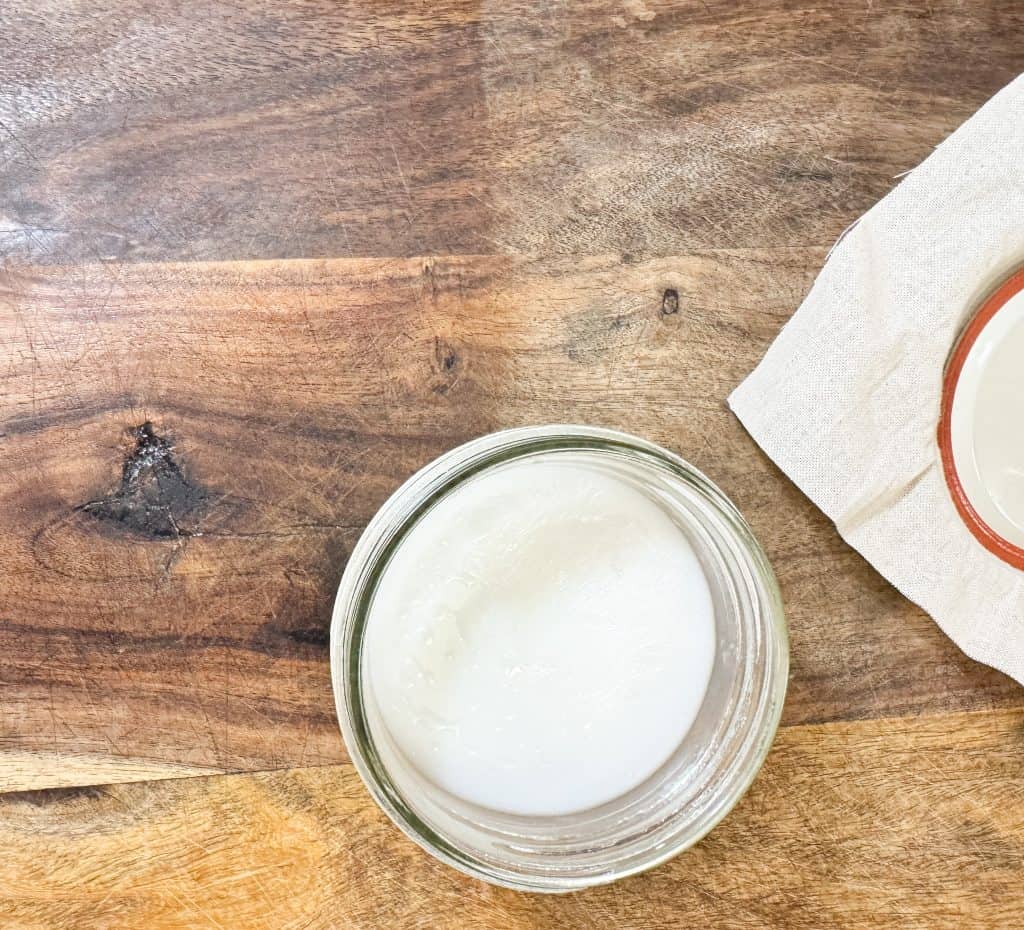Homemade Wood Cutting Board Butter
If your wooden kitchen items are looking dry or worn, making your own homemade wood cutting board butter is the best way to bring them back to life. It’s a simple mixture of natural ingredients that adds a protective layer to your wooden cutting board, wooden spoons, and wooden bowls. This DIY board butter recipe uses food-safe oil and natural wax—no toxic chemicals, no petroleum product—just good, clean care for surfaces that touch your food.
**This post contains affiliate links. We are a participant in the Amazon Services LLC Associates Program, an affiliate advertising program designed to provide a means for us to earn a small commission by linking to Amazon.com and affiliated websites.
Why Make Your Own Wood Cutting Board Butter?
Many store-bought wood conditioners contain petroleum-based oil, synthetic fragrances, or other ingredients not approved for human consumption. That’s not something you want near your food preparation area. This homemade version uses only food-grade, natural products like beeswax and MCT oil (a type of coconut oil made of medium-chain triglycerides), giving you a safer, more effective finish for daily use.
Using board butter helps prevent water absorption, cracking, and wear from daily use. It’s especially helpful for butcher block countertops, cutting boards, and any wooden utensil or wood board in your kitchen.
Ingredients for Wood Cutting Board Butter
- 2 tablespoons beeswax pellets (part beeswax is key to the right texture)
- 1/2 cup coconut MCT oil (or substitute with another natural oil like sunflower oil, jojoba oil, walnut oil, or grapeseed oil)
- Optional: A few drops of essential oils like lemon oil for scent
- Optional: Add a few drops of vitamin E for longer shelf life
Why MCT Coconut Oil Is a Great Choice
Coconut oil is often chosen for cutting board oil because it’s a natural product that doesn’t go rancid as quickly as many vegetable oils. MCT oil, or medium-chain triglycerides, is a form of coconut oil that stays liquid at room temperature, making it easier to work with and perfect for board butter. Unlike plain coconut oil or vegetable oils, MCT oil penetrates wood fibers easily and leaves behind a smooth, food-safe finish without an unpleasant smell. It’s a good idea to avoid oils that spoil quickly when working with items used in food preparation.
Why You Should Avoid Vegetable Oils and Petroleum-Based Oil
It might be tempting to grab whatever oil is in your pantry, but not all oils are safe for wooden utensils or wooden cutting boards. Vegetable oils and petroleum-based oil products can leave behind a sticky residue, go rancid, or give off a strong odor over time. These oils are not meant for human consumption in this form and can break down the integrity of your wood board. Sticking to food-safe oil like MCT oil, walnut oil, or jojoba oil ensures a longer-lasting, protective layer and better results.
Other Oils That Work Well
If you don’t have coconut oil or MCT oil, there are several natural alternatives that make good substitutes. Pure tung oil is one of the best oil choices for a tough, water-resistant finish, but make sure it’s marked food-safe. Walnut oil is another option, though not recommended for those with nut allergies. Jojoba oil, grapeseed oil, and sunflower oil are also popular choices. These oils are often easier to find at natural health stores or online than at the average drug store or hardware stores.
Can You Add Other Natural Ingredients?
Many people choose to customize their wood butter by adding essential oils like lemon oil or orange oil for a fresh scent. Just be sure any oils you add are safe for contact with food. Some users also add small amounts of vitamin E, not for moisturizing the board, but to extend the shelf life of the butter. If you’re someone who enjoys natural products and DIY recipes, experimenting with small pieces of different ingredients is part of the fun.
Tools You’ll Need for Wood Cutting Board Butter
- Half-pint glass jar (with or without a pour spout)
- Small pot (or bottom of the crock if using a crock pot)
- Clean cloth or paper towel for applying
- Wooden spoon or stick for periodic stirring

Instructions for Wood Cutting Board Butter
Making your own wood cutting board butter is simple and quick. Follow these easy steps for the best results using food-safe, natural ingredients.
Set up a Double Boiler
Place a half-pint glass jar into a small saucepan. Add about 2 inches of warm water to the pot, making sure the water surrounds the jar without getting inside it. This acts as a gentle double boiler to slowly heat your mixture without burning it.
Add your Ingredients
Measure out 2 tablespoons of beeswax pellets and 1/2 cup of MCT coconut oil. Pour both into the jar. If you’d like, you can also add a few drops of essential oils for scent (like lemon oil) or a few drops of vitamin E to help preserve the butter longer.
Slowly Heat the Mixture
Turn your stovetop to medium heat. As the water begins to warm, the ingredients in the jar will start to melt. Stir occasionally using a wooden stick, skewer, or spoon. The beeswax will take a little longer to melt than the oil, but that’s normal. Stirring helps everything blend well and keeps the mixture from separating.
Make sure Everything Melted and Combined.
Continue heating and stirring until you no longer see any bits of wax. The mixture should look clear and smooth. Once everything is fully melted and mixed together, carefully remove the jar from the hot water.
Cool and Store
Let the mixture sit at room temperature until it cools and solidifies. This usually takes a few hours. Once solid, place a lid on the jar and store it in a dark place away from heat. The butter should last a long time and stay fresh for repeated use.
How to Use Board Butter
Scoop a small amount with a clean cotton cloth or paper towel and rub it into the surfaces of the board or other wood utensils. Let it soak in overnight. The next morning, buff off any excess oil with a dry clean cloth. For old cutting boards or ones that haven’t been treated for a long time, repeat the process for best results.

How Often Should You Use Board Butter?
For new cutting boards or ones that haven’t been treated in a long time, it’s important to condition them once a week for the first month. After that, applying board butter once every few weeks or after every few washes is enough for daily use. Regular treatment helps maintain the best finish and prevents the wood from drying out. It’s especially important if you use hot water to clean your boards, since heat can strip away oils and leave wood looking dull or cracked.
Other Uses for Homemade Board Butter
This board butter isn’t just for cutting boards. You can also use it on butcher block countertops, wooden spoons, wooden kitchen utensils, and even small decorative wooden items. Many people use it as a spoon butter to keep their wooden tools smooth and clean. It’s also a better tool for maintaining wood than just plain mineral oil or plain coconut oil on its own.
Is It Safe for the Human Body?
Since this recipe contains food-grade, pharmaceutical grade ingredients like MCT oil and beeswax, it’s completely safe to touch and use on kitchen surfaces. There’s no risk if it comes into contact with food, making it far better than any petroleum product or synthetic polish. Using homemade wood butter made from organic materials gives peace of mind that you’re avoiding any additives not meant for the human body.
Storing Your Homemade Board Butter
Once your board butter cools and hardens, keep it sealed and stored in a dark place at room temperature. It will last a long time, especially if you’ve added vitamin E or essential oils. A small batch like this can be stored in mason jars and makes a great homemade gift too.
Conclusion
This DIY board butter is the best oil treatment for your wood kitchen items. It uses natural oils and avoids unnecessary additives found in drug store brands. Whether you’re refreshing an old reindeer-shaped holiday board or protecting a new cutting board, this is a better way to care for your wooden board collection. Want to see how we care for our cast iron around here? Check out our simple homemade cast iron seasoning paste.
Homemade Wood Cutting Board Butter
Equipment
- Half-pint glass jar (heat-safe, for melting and storage)
- Small saucepan or pot (to use as a double boiler)
- measuring spoons
- Measuring cup
- Wooden stick, spoon, or skewer (for stirring)
- Clean cotton cloth or paper towel (for applying butter)
- Lid for storage jar
Materials
- 2 tablespoons beeswax pellets
- 1/2 cup MCT coconut oil
- Optional: 3–5 drops lemon essential oil
- Optional: 5–10 drops vitamin E oil
Instructions
- Place a half-pint glass jar in a small pot with about 2 inches of water to create a double boiler effect.
- Add beeswax pellets and MCT oil to the jar.
- Heat over medium heat until fully melted, stirring occasionally.
- Remove from heat and stir in essential oils and/or vitamin E if using.
- Let sit at room temperature until solidified.
- Store in a cool, dark place with a lid.
Notes
Scoop a small amount with a clean cloth or paper towel. Rub into the wooden surface. Let sit overnight. Buff off any excess oil the next morning with a clean cloth.







